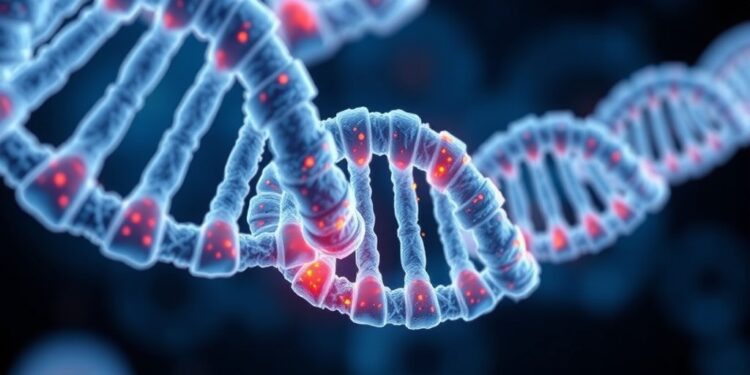For the first time in scientific history, the intricate moment of DNA unwinding has been directly witnessed, a groundbreaking event that elucidates the essential molecular dynamics necessary for the molecule that encodes all life. This remarkable revelation stems from a comprehensive study undertaken by researchers at the illustrious King Abdullah University of Science and Technology (KAUST), recently published in the esteemed journal Nature. The study captures the very genesis of DNA replication, highlighting the mechanisms that are vital for cells to accurately duplicate their genetic material—a fundamental process for growth, development, and reproduction.
Employing advanced cryo-electron microscopy paired with cutting-edge deep learning techniques, the collaborative research efforts led by KAUST’s Assistant Professor Alfredo De Biasio and Professor Samir Hamdan have unveiled unprecedented insights into the dynamics between helicases and DNA. Their work provides an enhanced understanding of the initial steps of DNA replication by identifying and detailing 15 discrete atomic states that describe how helicases, an essential enzyme, exert force to unwind DNA. This milestone not only marks a significant advancement in helicase research but also sets a new standard for studying the dynamic behavior of any enzyme at an atomic resolution.
While the critical role of helicases in DNA replication has been established over the years, the precise mechanics of their interactions with DNA and adenosine triphosphate (ATP) remained elusive until now. Professor De Biasio aptly noted the previous limitation in comprehension: “Scientists did not know how DNA, helicases, and ATP work together in a coordinated cycle to drive DNA unwinding.” This understanding is pivotal, as the unwinding of the double-helix structure of DNA is a prerequisite for replication to occur—an essential step in the perpetuation of life.
The historically significant revelation occurred when Watson and Crick first introduced the double helix model in 1953, paving the way for contemporary genetics. For DNA to replicate correctly, the DNA double-helix must first undergo unwinding, thereby converting the stable double strands into two accessible single strands. This unwinding is facilitated by helicases, which work to ‘melt’ DNA by breaking the chemical bonds that maintain the helix’s integrity. Following this, they physically pull the strands apart, enabling other enzymes to carry out the replication process effectively. Without this vital initial enzymatic action, the replication process is rendered impossible.
Characterizing helicases as molecular machines—or, given their minuscule size, nanomachines—illustrates their complexity and function within cellular biology. The ATP molecules act as the essential fuel for these nanomachines, akin to how gasoline propels a car engine. Through the consumption of ATP, the helicase functions like the pistons of an engine, exerting force to unwind the tightly coiled DNA structure. The current research indicates that as ATP is utilized in the unwinding process, it diminishes the physical impediments limiting helicase movement along the DNA, progressively unwinding the double strands more extensively. Thus, ATP serves as a switch that heightens the entropy, or disorder, within the system, liberating helicases to advance along the DNA strand.
Further articulating the mechanics, De Biasio states, “The helicase uses ATP not to pry DNA apart in one motion but to cycle through conformational changes that progressively destabilize and separate the strands.” In this light, ATP hydrolysis operates similarly to the mechanism of a mouse trap, wherein the potential energy stored within the spring is unleashed to propel the trap forward. As helicases consume ATP, they transition through various conformational states, which collectively destabilize the DNA strands, facilitating the unwinding process.
One of the notable discoveries made by the KAUST researchers was the observation that two helicases can unwind DNA simultaneously at two distinct sites. This coordinated action is vital because, in biological systems, helicases are programmed to move along a single DNA strand unidirectionally. By binding to dual sites concurrently, helicases synchronize their activity, allowing for bidirectional unwinding while maintaining a level of energy efficiency that is characteristic of natural nanomachines. The specific coordination exhibited during this dual site binding exemplifies the precision of molecular interactions that drive biochemical processes.
De Biasio elaborates on the relevance of energy efficiency in this context, indicating that the implications of studying DNA replication extend beyond merely addressing fundamental scientific inquiries about life itself. He argues that helicases serve as exemplary models for the design of innovative nanotechnology. The extraordinary mechanics displayed by helicases illustrate how engineered nanomachines could adopt similar principles of energy-efficient operations to accomplish complex tasks driven by force.
The findings from this study not only advance our understanding of DNA replication at a molecular level but also imply profound potential applications in biomedicine and nanotechnology. The ability to manipulate and interpret the structural dynamics of helicases may lead to the development of novel therapeutic approaches for genetic diseases and engineered systems designed to perform intricate biochemical reactions in controlled settings.
In summary, the groundbreaking observations made by the KAUST team offer a new lens through which scientists can comprehend the intricacies of DNA replication. By revealing the atomic-scale dynamics underpinning this process, the work not only enhances our knowledge of fundamental biology but also sets the stage for innovative advancements in technology inspired by the efficiency and design of natural molecular machines.
Subject of Research:
Article Title: Structural dynamics of DNA unwinding by a replicative helicase
News Publication Date: 19-Mar-2025
Web References: DOI Link
References: None
Image Credits: None
Keywords
DNA replication, Helicases, Structural dynamics, Molecular machines, Nanotechnology, Biochemistry, Genetics.
Tags: advanced cryo-electron microscopy techniquesatomic resolution enzyme studiesdeep learning in scientific researchDNA unwinding mechanismsearly stages of DNA replicationfundamental processes of lifegenetic material duplication processeshelicase dynamics in DNAinsights into DNA helicasesKAUST research contributionsmolecular biology breakthroughsmolecular dynamics of DNA.





